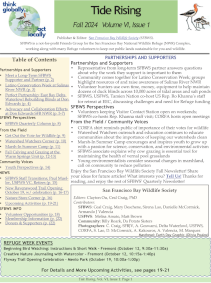Migratory Bird Treaty Celebrates 100 Years 1916-2016
This year we mark the centennial of the Convention between the United States and Great Britain (for Canada) for the Protection of Migratory Birds - also called the Migratory Bird Treaty - that was signed on Aug. 16, 1916. This Migratory Bird Treaty (446.6KB), and three others that followed, form the cornerstones of our efforts to conserve birds that migrate across international borders.
The treaty connects the U.S. Fish & Wildlife Service with our federal, state, private, non-government, tribal, and international partners who share a long, successful history of conserving, protecting, and managing migratory bird populations and their habitats. Celebrating the centennial of the first treaty allows us to bring together those who have contributed to its success, and to galvanize efforts to protect migratory birds for generations to come.

Girls birding. Photo courtesy Jennie Duberstein/US FWS..
Migratory birds...
- connect people with nature and add beauty, sound and color to our world. They provide countless opportunities for enjoyment by birders, hunters, and outdoor enthusiasts, and they have cultural and spiritual importance.
- contribute environmental benefits, including pollination, insect and rodent control, and seed dispersal.
- are good indicators of environmental health because they are so visible and are relatively easy to study. Studying birds can give us a picture of what is going on in the natural world.
- play a key role in the U.S. economy, supporting recreational opportunities (22.9MB) that create jobs and generate billions of dollars in revenue.
Centennial Campaign Goals
Create awareness about the importance of migratory bird conservation by encouraging news media stories about treaty achievements, migratory birds, and habitat conservation, and connecting people to migratory bird conservation via social media.

Hunters at Mingo National Wildlife Refuge. Photo courtesy US FWS.
Promote key actions that anyone can take to help birds. This includes participating in citizen science programs such as bird counts; expanding property and homeowner use of bird-friendly practices such as lights out programs, reducing collisions, and maintaining wildlife-friendly gardens; and increasing sales of the Federal Duck Stamp, which protects habitat for migratory birds.
Increase support for migratory bird conservation programs and initiatives by strengthening naitonal and international partnerships and increasing knowledge and understanding of key legislation for migratory birds.

Golden-winged warblers are among the more than 1,000 species protected as a result of the Migratory Bird Treaty. Photo courtesy US FWS.
Expand opportunities for engagement in activities such as bird watching, hunting, and conservation, including bird-focused programs and festivals, especially in Urban Bird Treaty Cities and Urban Refuge Partnerships, International Migratory Bird Day events; participation in the Junior Duck Stamp program; and youth birding and hunting events at national wildlife refuges.


